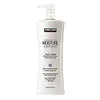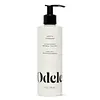What's inside
What's inside
 Key Ingredients
Key Ingredients

No key ingredients
 Benefits
Benefits

 Concerns
Concerns

 Ingredients Side-by-side
Ingredients Side-by-side

Water
Skin ConditioningCetearyl Alcohol
EmollientStearamidopropyl Dimethylamine
EmulsifyingGlycerin
HumectantPropanediol
SolventBehentrimonium Methosulfate
Cetrimonium Chloride
AntimicrobialDimethicone
EmollientIsododecane
EmollientIsohexadecane
EmollientCitric Acid
BufferingParfum
MaskingHydroxyethylcellulose
Emulsion StabilisingPhenoxyethanol
PreservativeCaprylyl Glycol
EmollientGlyceryl Stearate
EmollientPPG-3 Benzyl Ether Myristate
EmollientGuar Hydroxypropyltrimonium Chloride
Skin ConditioningAmodimethicone
Polyquaternium-73
Sodium Benzoate
MaskingQuaternium-87
CleansingIsopentyldiol
HumectantDisodium EDTA
Butyrospermum Parkii Butter
Skin ConditioningSodium Stearoyl Glutamate
CleansingJojoba Esters
EmollientC11-15 Pareth-7
EmulsifyingLaureth-9
EmulsifyingTrideceth-12
EmulsifyingHydrolyzed Vegetable Protein Pg-Propyl Silanetriol
Skin ConditioningAcetic Acid
BufferingGlycereth-26
HumectantSodium Hydroxide
BufferingEtidronic Acid
Potassium Sorbate
PreservativeHelianthus Annuus Seed Oil
EmollientPentaerythrityl Tetra-Di-T-Butyl Hydroxyhydrocinnamate
AntioxidantPhospholipids
Skin ConditioningArgania Spinosa Kernel Oil
EmollientPersea Gratissima Oil
Skin ConditioningAscorbic Acid
AntioxidantTocopheryl Acetate
AntioxidantCopaifera Officinalis Resin
MaskingIsomalt
HumectantQuaternium-95
UV AbsorberTocopherol
AntioxidantPanthenol
Skin ConditioningPassiflora Edulis Seed Oil
EmollientGlycine Soja Oil
EmollientEuterpe Oleracea Fruit Oil
Skin ConditioningHydrolyzed Pea Protein Pg-Propyl Silanetriol
Skin ConditioningAloe Barbadensis Leaf Extract
EmollientCamellia Sinensis Leaf Extract
AntimicrobialCucumis Sativus Fruit Extract
EmollientLycium Barbarum Fruit Extract
AstringentPersea Gratissima Fruit Extract
EmollientPunica Granatum Extract
AstringentMalus Domestica Fruit Cell Culture Extract
Skin ConditioningAlcohol
AntimicrobialVitis Vinifera Seed Extract
AntimicrobialXanthan Gum
EmulsifyingLecithin
EmollientVitis Vinifera Fruit Cell Extract
Skin ConditioningWater, Cetearyl Alcohol, Stearamidopropyl Dimethylamine, Glycerin, Propanediol, Behentrimonium Methosulfate, Cetrimonium Chloride, Dimethicone, Isododecane, Isohexadecane, Citric Acid, Parfum, Hydroxyethylcellulose, Phenoxyethanol, Caprylyl Glycol, Glyceryl Stearate, PPG-3 Benzyl Ether Myristate, Guar Hydroxypropyltrimonium Chloride, Amodimethicone, Polyquaternium-73, Sodium Benzoate, Quaternium-87, Isopentyldiol, Disodium EDTA, Butyrospermum Parkii Butter, Sodium Stearoyl Glutamate, Jojoba Esters, C11-15 Pareth-7, Laureth-9, Trideceth-12, Hydrolyzed Vegetable Protein Pg-Propyl Silanetriol, Acetic Acid, Glycereth-26, Sodium Hydroxide, Etidronic Acid, Potassium Sorbate, Helianthus Annuus Seed Oil, Pentaerythrityl Tetra-Di-T-Butyl Hydroxyhydrocinnamate, Phospholipids, Argania Spinosa Kernel Oil, Persea Gratissima Oil, Ascorbic Acid, Tocopheryl Acetate, Copaifera Officinalis Resin, Isomalt, Quaternium-95, Tocopherol, Panthenol, Passiflora Edulis Seed Oil, Glycine Soja Oil, Euterpe Oleracea Fruit Oil, Hydrolyzed Pea Protein Pg-Propyl Silanetriol, Aloe Barbadensis Leaf Extract, Camellia Sinensis Leaf Extract, Cucumis Sativus Fruit Extract, Lycium Barbarum Fruit Extract, Persea Gratissima Fruit Extract, Punica Granatum Extract, Malus Domestica Fruit Cell Culture Extract, Alcohol, Vitis Vinifera Seed Extract, Xanthan Gum, Lecithin, Vitis Vinifera Fruit Cell Extract
Ingredients Explained
These ingredients are found in both products.
Ingredients higher up in an ingredient list are typically present in a larger amount.
Alcohol comes in many different forms. Different types of alcohol will have different effects on skin. This ingredient is usually an astringent alcohol.
These alcohols are drying on the skin. They may strip away your skin's natural oils and even damage your skin barrier. Astringent alcohols may also irritate skin.
Other types of astringent alcohols include:
According to the National Rosacea Society based in the US, you should be mindful of products with these alcohols in the top half of ingredients.
Any type of sanitizing product will have high amounts of alcohol to help kill bacteria and viruses.
Fatty alcohols come from plant oils such as coconut oil. These can help hydrate the skin and are non-irritating. Some fatty alcohols include cetyl and stearyl alcohol.
Learn more about AlcoholThis water-soluble silicone is used for its hydrating and softening properties. It is used to add a silky feel to skincare products and has great benefits for haircare.
In haircare, this ingredient:
- Adds shine
- Protects color
- Offers thermal protection
- Boosts hair strength
- Does not build up as easily
Cetearyl alcohol is a mixture of two fatty alcohols: cetyl alcohol and stearyl alcohol. It is mainly used as an emulsifier. Emulsifiers help prevent the separation of oils and products. Due to its composition, it can also be used to thicken a product or help create foam.
Cetearyl alcohol is an emollient. Emollients help soothe and hydrate the skin by trapping moisture.
Studies show Cetearyl alcohol is non-toxic and non-irritating. The FDA allows products labeled "alcohol-free" to have fatty alcohols.
This ingredient is usually derived from plant oils such as palm, vegetable, or coconut oils. There is debate on whether this ingredient will cause acne.
Due to the fatty acid base, this ingredient may not be Malassezia folliculitis safe.
Learn more about Cetearyl AlcoholThis ingredient is a preservative, antimicrobial, and emulsifier. It is often used in cosmetics for its ability to cleanse, condition, and reduce static.
Cetrimonium chloride is a quaternary ammonium salt, meaning it has a water-soluble structure.
Parfum is a catch-all term for an ingredient or more that is used to give a scent to products.
Also called "fragrance", this ingredient can be a blend of hundreds of chemicals or plant oils. This means every product with "fragrance" or "parfum" in the ingredients list is a different mixture.
For instance, Habanolide is a proprietary trade name for a specific aroma chemical. When used as a fragrance ingredient in cosmetics, most aroma chemicals fall under the broad labeling category of “FRAGRANCE” or “PARFUM” according to EU and US regulations.
The term 'parfum' or 'fragrance' is not regulated in many countries. In many cases, it is up to the brand to define this term.
For instance, many brands choose to label themselves as "fragrance-free" because they are not using synthetic fragrances. However, their products may still contain ingredients such as essential oils that are considered a fragrance by INCI standards.
One example is Calendula flower extract. Calendula is an essential oil that still imparts a scent or 'fragrance'.
Depending on the blend, the ingredients in the mixture can cause allergies and sensitivities on the skin. Some ingredients that are known EU allergens include linalool and citronellol.
Parfum can also be used to mask or cover an unpleasant scent.
The bottom line is: not all fragrances/parfum/ingredients are created equally. If you are worried about fragrances, we recommend taking a closer look at an ingredient. And of course, we always recommend speaking with a professional.
Learn more about ParfumPhenoxyethanol is a preservative that has germicide, antimicrobial, and aromatic properties. Studies show that phenoxyethanol can prevent microbial growth. By itself, it has a scent that is similar to that of a rose.
It's often used in formulations along with Caprylyl Glycol to preserve the shelf life of products.
Propanediol is an all-star ingredient. It softens, hydrates, and smooths the skin.
It’s often used to:
Propanediol is not likely to cause sensitivity and considered safe to use. It is derived from corn or petroleum with a clear color and no scent.
Learn more about PropanediolWe don't have a description for Trideceth-12 yet.
Water. It's the most common cosmetic ingredient of all. You'll usually see it at the top of ingredient lists, meaning that it makes up the largest part of the product.
So why is it so popular? Water most often acts as a solvent - this means that it helps dissolve other ingredients into the formulation.
You'll also recognize water as that liquid we all need to stay alive. If you see this, drink a glass of water. Stay hydrated!
Learn more about Water